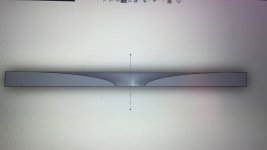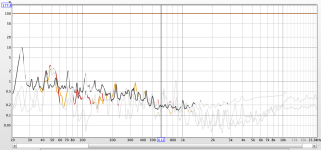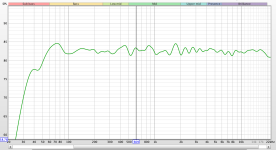However, the driver is not completely undamped: the phase plug and the short truncated cone placed at the output of the driver still result in a certain amount of load. In addition, the reduced damping of the diaphragm could have perceptible effects in terms of distortion at spl levels so high as to be unworkable in the home environment. Before doing these tests, I made measurements to see if turning up the volume a bit would drastically increase distortion, precisely because I feared this phenomenon.It is in the sense that it's now a BR tuned way above its Fs or even more so if its throat/vent is plugged. Correct.
edit: Note that a compression horn is composed of an under damped driver (Qts' > ~0.403) coupled to an over damped (heavy air mass 'plug') vent that when properly designed as a system with be 'critically' damped over the driver's designed BW.
In any case, these are dogmatic statements: you have to look at the distortion and the measurements to see if the phenomena you suspect might be occurring are really occurring.
Well, at least in those 3 videos there Is something to hear
Technically, GM was to parametrize the coefficient of gaussian disposition of the molecules under the impulse of the motus of the membrane, i.e. air resistance
Technically, GM was to parametrize the coefficient of gaussian disposition of the molecules under the impulse of the motus of the membrane, i.e. air resistance
As bonus tracks I send you the same tracks played by tpl 200. Everything else in the chain is the same. The crossover points are also the same. Again there is equalization to get a flat 60-20000 frequency.
I know that this is a rather low cutoff for the tpl 200 but it is still within the manufacturer's recommended range (>1000hz) and I need to mantain all the settings as similar as possible to judge with a minimum of objectivity
I know that this is a rather low cutoff for the tpl 200 but it is still within the manufacturer's recommended range (>1000hz) and I need to mantain all the settings as similar as possible to judge with a minimum of objectivity
Attachments
Am I the only hearing reflection & diffraction from Edge on the second video? 😉
Plus the ambience effects of the woofer (if played...but, yes..It must play...yes?)
Summed to the same reflection & diffraction from edge on the second part of the table...mono has some winning points...great videos!
Plus the ambience effects of the woofer (if played...but, yes..It must play...yes?)
Summed to the same reflection & diffraction from edge on the second part of the table...mono has some winning points...great videos!
For work I am in the business of doing research: I spend all day making measurements and statistics. I have learned that theoretical statements are of little use while measurements speak much more. Try listening and make up your own mind. I can assure you that there are no differences in distortion so obvious as to justify what you will hear. On the other hand, if there were very obvious distortion it would be very noticeable by your ears, right?Well, at least in those 3 videos there Is something to hear
Technically, GM was to parametrize the coefficient of gaussian disposition of the molecules under the impulse of the motus of the membrane, i.e. air resistance
I think it is much more important to express an opinion, since measurements and consequently theory, which after all is derived from measurements, do not come easily to our rescue.
The differences here are very subtle, all systems sound quite good, and the differences you will hear are subject to your personal tastes. After all, here we are not building measuring instruments but something that produces a sound that we subjectively appreciate. Besides, it is much more fun to discuss something innovative than to keep repeating established patterns.
😂 Yes, the room roof of my basement is low an there are some diffractions due to the setting. However these factors are almost constant in all the clips. The woofer is playing and the response is flat but this is what you hear from the phone mic 😢. For the moment this is the best I have at hand to feed you.Am I the only hearing reflection & diffraction from Edge on the second video? 😉
Plus the ambience effects of the woofer (if played...but, yes..It must play...yes?)
Summed to the same reflection & diffraction from edge on the second part of the table...mono has some winning points...great videos!
Last edited:
Whereas the system is not definitive and is solely for evaluating how the driver with and without a horn sounds, what I hear live is that the system without a horn sounds closest to what, as far as I remember, these artists have live. The other two configurations sound very good but deviate slightly from the sound that I perceive subjectively as more realistic. Obviously these are purely personal and exclusively subjective evaluations. I am very interested in your opinion: if there is someone who, like me, perceives the sound of the hornless driver as more realistic then perhaps it will be worth experimenting and playing with it some more.
Stil if flat equalized (??), the kind of radiation Is different and mostly influenced from how the rear radiation Is damped. Many experts on CDs around here...slightly from the sound that I perceive subjectively as more realistic.
And..
It sounds like you are 'tattoed' to a V shape kind of EQ...!?!
Yes, flat equalization at the listening point (you can see the calibrated mic tip in the clips), that allows different dispersion patterns to exert these effects. These effects are varying only in the 1000-10000 range however since the nd3st/tpl200 are limited to this freq. range. Below and above jbl2226j and beyma cp21 which crossover and equalization is kept constant.
Last edited:
Maybe it is the non linear response of the phone mic. It is interesting to investigate! Maybe room reflections? the room is very reflective but nothing so far from a minimalistic living room which I like most. The equalization at the measurement point was very flat and was double checked So no V shape equalization.Stil if flat equalized (??), the kind of radiation Is different and mostly influenced from how the rear radiation Is damped. Many experts on CDs around here...
And..
It sounds like you are 'tattoed' to a V shape kind of EQ...!?!
Last edited:
Thank you for these clips, very interesting!
My subjective impression, through my trusted old Sennheiser HD500 Precision headphones, is that the hornless combo sounds dull, lacks inflection, articulation and dynamics - specifically in the strings and vocals.
Note pitch is flattened and judged in terms of musical performance it is simply more flat and less engaging. This is imo fairly typical for listeners that go for a pleasant overall sound rather than a device that is optimized for the reproduction of the communication of musical intent that engages the listener. I’ll easily trade a ‘pipe sound’ for that. It’s sorta like focusing on the bugs on the windshield rather than the road.
My subjective impression, through my trusted old Sennheiser HD500 Precision headphones, is that the hornless combo sounds dull, lacks inflection, articulation and dynamics - specifically in the strings and vocals.
Note pitch is flattened and judged in terms of musical performance it is simply more flat and less engaging. This is imo fairly typical for listeners that go for a pleasant overall sound rather than a device that is optimized for the reproduction of the communication of musical intent that engages the listener. I’ll easily trade a ‘pipe sound’ for that. It’s sorta like focusing on the bugs on the windshield rather than the road.
Yes, the tests are completely flawed and the record testifys it!
But that's not a problem since:
the aberrations are 'embedded'
the mono record of a mono source and approximation of single point source in rendering trough a video/record
A stereo set with single mic caption( how limited in band and how it will be reproduced is a chapter that is already closed, since the variations could be heard with a mobile, go figure...) would add +6 dB of the whole chaos so permanently derailing from original idea of presenting a humble disposition of membranes orthogonal to a plane. But this hasn't happened.
Now, if [one] makes a mono set with mono caption but with driver correctly disposed in space with no aberrations from [the so-called room influences ] in order to have a neutral basis to speculate upon
That would be a significant step upwards - just the first one in this occasion
But that's not a problem since:
the aberrations are 'embedded'
the mono record of a mono source and approximation of single point source in rendering trough a video/record
A stereo set with single mic caption( how limited in band and how it will be reproduced is a chapter that is already closed, since the variations could be heard with a mobile, go figure...) would add +6 dB of the whole chaos so permanently derailing from original idea of presenting a humble disposition of membranes orthogonal to a plane. But this hasn't happened.
Now, if [one] makes a mono set with mono caption but with driver correctly disposed in space with no aberrations from [the so-called room influences ] in order to have a neutral basis to speculate upon
That would be a significant step upwards - just the first one in this occasion
Duller but not dull at all! Compared with the tpl200 which is anything but dull the driver without a horn is no more dull. With the horn there is indeed more dynamics but here we are still talking about a system that compared to a non-compression driver (a dome tweeter for example) is still more dynamic. I also like the dynamics of the horn more but at what price? Live the horn sounds like you have your hands in front of your mouth.Thank you for these clips, very interesting!
My subjective impression, through my trusted old Sennheiser HD500 Precision headphones, is that the hornless combo sounds dull, lacks inflection, articulation and dynamics - specifically in the strings and vocals.
Note pitch is flattened and judged in terms of musical performance it is simply more flat and less engaging. This is imo fairly typical for listeners that go for a pleasant overall sound rather than a device that is optimized for the reproduction of the communication of musical intent that engages the listener. I’ll easily trade a ‘pipe sound’ for that. It’s sorta like focusing on the bugs on the windshield rather than the road.
Having listened to the system live I notice that some parts of the sound (dynamics for example) are well reported of the recording while others (ambience for example, as much as possible since the system is mono) is no longer perceptible.
As a final consideration, I am fascinated by the measuring instrument vs. playful instrument diatribe: do you think the speaker system should be more accurate and truthful or more enjoyable? If you have to sacrifice something in which of the two categories do you fall? What is the purpose for which you build your hifi systems?
Last edited:
We have to make do with what we have: the time I have to devote to this game is limited. Nevertheless given a set of phenomena I want to compare, if the transformation (the room-instrument system i.e., the telephone and its microphone)is the same for all samples, then comparison is always possible. What we cannot do is judge the system in absolute terms, only in terms relative to the three systems shown here.Yes, the tests are completely flawed and the record testifys it!
But that's not a problem since:
the aberrations are 'embedded'
the mono record of a mono source and approximation of single point source in rendering trough a video/record
A stereo set with single mic caption( how limited in band and how it will be reproduced is a chapter that is already closed, since the variations could be heard with a mobile, go figure...) would add +6 dB of the whole chaos so permanently derailing from original idea of presenting a humble disposition of membranes orthogonal to a plane. But this hasn't happened.
Now, if [one] makes a mono set with mono caption but with driver correctly disposed in space with no aberrations from [the so-called room influences ] in order to have a neutral basis to speculate upon
That would be a significant step upwards - just the first one in this occasion
I have a shorter horn with a wider dispersion on the way: https://www.eighteensound.it/en/products/horn/1-4/0/XR1496C indeed with a 1000hz crossover I don't need to have the loading of the horn I tried now. Also as a Solomonic middle ground I also want to try to test this system by putting the driver in a horn with a very wide dispersion(140°x80°) but very shallow, I attach pictures of the elliptical profile horn I designed. Nothing particularly sophisticated-I used celestion's horn wizard and then brought it back in 3D. I just hope to find a CNC shop that won't charge me a fortune to make it! As soon as I have some new evidence I will send you the video to hear your opinions.
Attachments
Last edited:
Here the response and the distortion of the hornless system. Note that at 2 meter in a very reflecting room especially the THD measurement is biased toward higher THD levels. Nonetheless the THD is under 1% from 150 to 20000hz: the driver is not under particular stress.
Attachments
Hi,
My personal thoughts are, there are distortion which are caused by the surface on the horn itself. As you know, modelling is actually just a simplification of all the physical processes that are happening on the horn. I suspect that the surface of the horn causes early reflections, resulting in smearing of the sound as well as diffraction etc. It becomes more significant as frequency rises and wavelengths become only a few centimeters long at frequencies approaching 10kHz. Similar to effect the baffle has on a tweeter. However since the surfaces of the horn is in front of the source, this becomes even more prominent. Of course I don't have any proof of this. Just my 2cents.
My personal thoughts are, there are distortion which are caused by the surface on the horn itself. As you know, modelling is actually just a simplification of all the physical processes that are happening on the horn. I suspect that the surface of the horn causes early reflections, resulting in smearing of the sound as well as diffraction etc. It becomes more significant as frequency rises and wavelengths become only a few centimeters long at frequencies approaching 10kHz. Similar to effect the baffle has on a tweeter. However since the surfaces of the horn is in front of the source, this becomes even more prominent. Of course I don't have any proof of this. Just my 2cents.
- Home
- Loudspeakers
- Multi-Way
- The Official HORNLESS Compression Driver Thread



